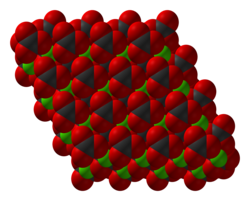Cobalt(II) carbonate
Co2+ CO32−
| |
 | |
| Names | |
|---|---|
| IUPAC name
Cobalt(II) carbonate
| |
| Other names
Cobaltous carbonate; cobalt(II) salt
| |
| Identifiers | |
| |
3D model (
JSmol ) |
|
| ChemSpider | |
ECHA InfoCard
|
100.007.428 |
PubChem CID
|
|
| UNII |
|
CompTox Dashboard (EPA)
|
|
| |
SMILES
| |
| Properties | |
| CoCO3 | |
| Molar mass | 118.941 g/mol |
| Appearance | pink solid |
| Density | 4.13 g/cm3 |
| Melting point | 427 °C (801 °F; 700 K) [3] decomposes before melting to cobalt(II) oxide (anhydrous) 140 °C (284 °F; 413 K) decomposes (hexahydrate) |
| 0.000142 g/100 mL (20 °C)[1] | |
Solubility product (Ksp)
|
1.0·10−10[2] |
| Solubility | soluble in acid negligible in alcohol, methyl acetate insoluble in ethanol |
Refractive index (nD)
|
1.855 |
| Structure | |
| Rhombohedral (anhydrous) Trigonal (hexahydrate) | |
| Thermochemistry | |
Std molar
entropy (S⦵298) |
79.9 J/mol·K[3] |
Std enthalpy of (ΔfH⦵298)formation |
−722.6 kJ/mol[3] |
Gibbs free energy (ΔfG⦵)
|
−651 kJ/mol[3] |
| Hazards | |
| GHS labelling: | |
  [4] [4]
| |
| Warning | |
| H302, H315, H317, H319, H335, H351[4] | |
| P261, P280, P305+P351+P338[4] | |
| NFPA 704 (fire diamond) | |
| Lethal dose or concentration (LD, LC): | |
LD50 (median dose)
|
640 mg/kg (oral, rats) |
Except where otherwise noted, data are given for materials in their standard state (at 25 °C [77 °F], 100 kPa).
| |
Cobalt(II) carbonate is the
Preparation and structure

Structure of solid cobalt(II) carbonate shown with space-filling ions. Color code: red = O, green = Co, blck = C
It is prepared by combining solutions of
- CoSO4 + 2 NaHCO3 → CoCO3 + Na2SO4 + H2O + CO2
This reaction is used in the precipitation of cobalt from an extract of its roasted ores.[5]
CoCO3 adopts a structure like
Reactions
Like most transition metal carbonates, cobalt carbonate is insoluble in water, but is readily attacked by mineral acids:
- CoCO3 + 2 HCl + 5 H2O → [Co(H2O)6]Cl2 + CO2
It is used to prepare many coordination complexes. The reaction of cobalt(II) carbonate and acetylacetone in the presence of hydrogen peroxide gives tris(acetylacetonato)cobalt(III).[8]
Heating the carbonate proceeds in a typical way for
- 6 CoCO3 + O2 → 2 Co3O4 + 6 CO2
The resulting
Uses
Cobalt carbonate is a precursor to
Related compounds
At least two cobalt(II) carbonate-hydroxides are known: Co2(CO3)(OH)2 and Co6(CO3)2(OH)8·H2O.[10]
The moderately rare
Safety
Toxicity has rarely been observed. Animals, including humans, require trace amounts of cobalt, a component of vitamin B12.[5]
References
- ISBN 978-1-4987-5429-3.
- ^ "Solubility product constants". Archived from the original on 2012-06-15. Retrieved 2012-05-17.
- ^ a b c d "Cobalt(II) carbonate".
- ^ a b c Sigma-Aldrich Co., Cobalt(II) carbonate. Retrieved on 2014-05-06.
- ^ ISBN 3527306730.
- ^ a b "Spherocobaltite: Spherocobaltite mineral information and data". www.mindat.org. Retrieved 7 August 2018.
- .
- )
- .
- S2CID 58657483.
External links
 Media related to Cobalt(II) carbonate at Wikimedia Commons
Media related to Cobalt(II) carbonate at Wikimedia Commons

